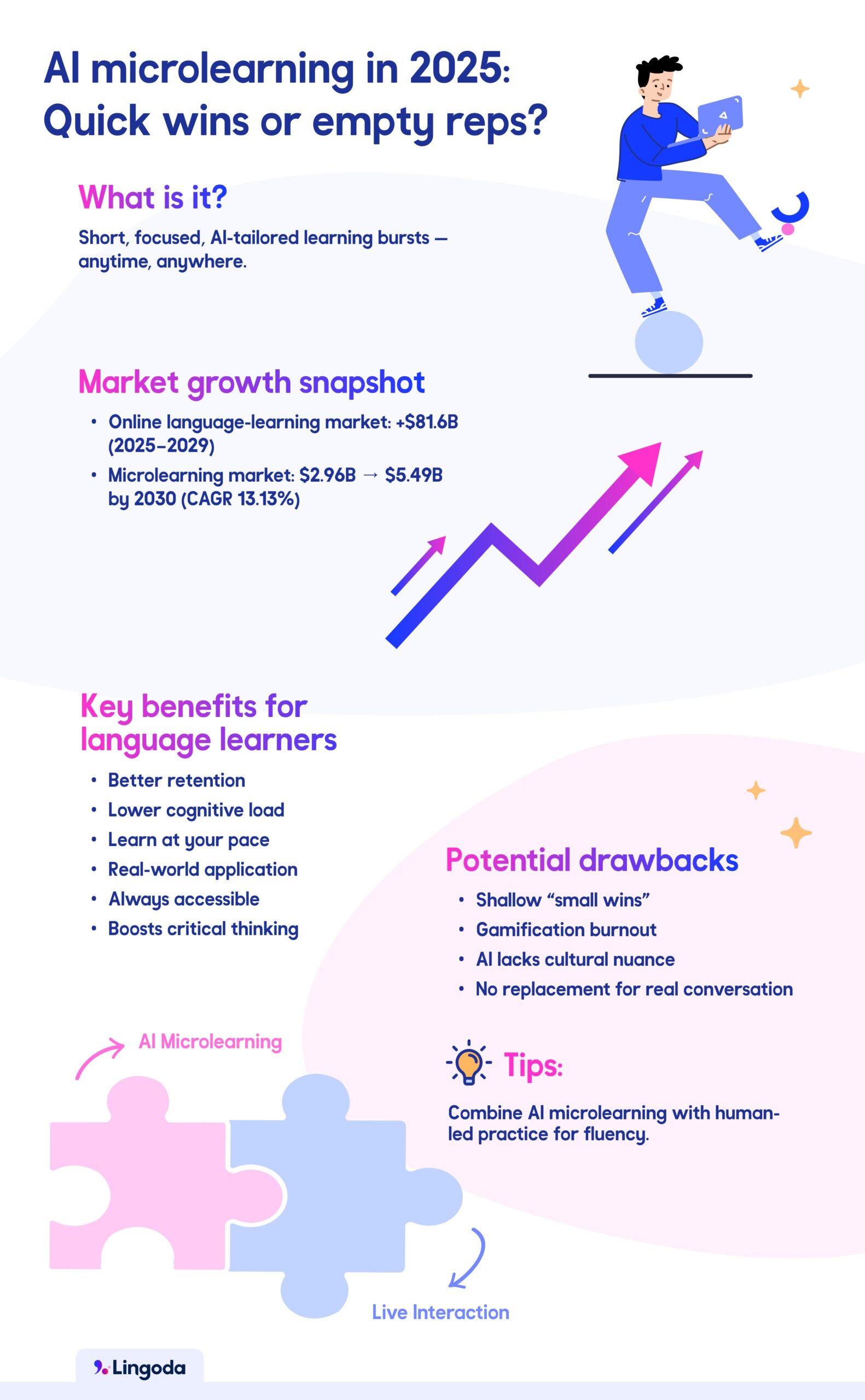The rise of AI microlearning in 2025: Quick wins or empty reps?
Life can get hectic. Work, commuting, and family responsibilities fill our days. When can we find time to pick up a new skill and stay on top of our game?

With today's competitive labor market, we can't afford to be complacent. Whether it’s earning new certificates or even picking up an entirely new language, we’re expected to continue learning.
That’s where AI-powered microlearning steps in. As the Assistant Dean of Digital Learning at NYU Tandon School of Engineering, Shivani Dhir, put it: “I see microlearning as being an approach to almost every part of continuous learning.”
Why? Well, microlearning’s short, focused format fits into even the busiest schedule, helping us stay consistent and on track.. Let’s explore what AI-driven microlearning is all about and whether it really can help us learn a new language (or not).
- What is AI‑powered microlearning in 2025?
- Market momentum: Why microlearning is trending now
- The upside: Why it appeals to language learners
- The critiques: Limits of microlearning and AI
What is AI‑powered microlearning in 2025?
Education is evolving fast, and one of the most impactful shifts is microlearning. . Microlearning delivers short, focused and mobile-first learning content that is easy to access and retain. In particular, its compatibility with smartphones and tablets makes it ideal for busy learners who want flexible, on-the-go learning in their pockets.
Formats range from videos and animations to quizzes and audio snippets - and AI is taking them to the next level. AI-powered language platforms can now personalize microlearning lessons to each learner’s progress and needs. The technology can even create immersive or gamified environments for practicing new skills. This keeps users engaged.
Here are the key benefits that AI-powered microlearning can offer language learners:
- Enhanced information processing and knowledge retention
- Reduced cognitive load, making complex topics easier to grasp
- Improved the ability to apply knowledge in real-world scenarios
- 24/7 access
- Allowing learners to go at their own pace
- Strengthened critical thinking
Additionally, when used in group settings, AI microlearning can also encourage collaboration.

Market momentum: Why microlearning is trending now
With all those benefits, it’s no surprise that microlearning and the usage of AI have gathered significant momentum in the language-learning industry. Let’s take a closer look at this trend:
Rapid growth driven by AI in language learning market
Research suggests that the global online language-learning market could grow as much as $81.6 billion between 2025 and 2029. This projection is fueled by factors such as:
- Cost-effectiveness and flexibility offered by online learning platforms
- The integration of AI in learning apps, enabling personalized learning through chatbots or immersive environments and reducing the time needed to learn a language
- A rising demand for multilingual skills in the labor market
- Democratization of education, making language learning more accessible and affordable
Microlearning market size and CAGR
Specifically, the microlearning market size is expected to grow from $2.96 billion to $5.49 billion by 2030, at a Compound Annual Growth Rate (CAGR) of 13.13%. This is being accelerated by the adoption of microlearning in schools, homes and workplaces. Research shows traditional methods (listening, reading, observing) often result in just 30% retention. On the other hand, microlearning’s bite-sized approach helps students boost retention and achieve better outcomes.
The upside: Why it appeals to language learners
What are the main benefits that microlearning can offer language learners who are already busy with daily life?
Low friction, daily habit formation
Quick sessions fit neatly into the daily life of busy working professional. From a quick vocabulary lesson to a sentence drill, microlearning offers a way to stay consistent and build a habit no matter where we are and how much time we have. This drives incremental, steady progress.
AI drives relevance and motivation
AI curates content to one’s goals, be it learning vocabulary for travel or work. Additionally, real-time feedback loops allow for faster improvement, which boosts motivation. This is all packed in platforms that use engaging features like gamification, virtual reality and challenges, which are all designed to help users stay committed.
The critiques: Limits of microlearning and AI
Let’s take a look at the other side of the coin:
Superficial “small wins” vs. real fluency
The lack of depth in microlearning lessons like word-of-the-day bits may hinder fluency. Sure, learning a new word gives us a quick "small win”, but without context, we won’t understand how to use it naturally.
Gamification fatigue and plateau risks
Gamification features like streaks or badges can be motivating in the short term, but the lack of structured progression and exposure to complex grammar may lead us to plateau.
AI‑generated content may lack nuance
AI-generated content can lack crucial context such as cultural nuances or natural usage of patterns and vocabulary. This gap can leave learners knowing vocabulary they can’t really use appropriately. As Robert Godwin‑Jones, a researcher in generative AI and second language learning, noted: “Generative AI lacks the lived experience to handle pragmatic nuance and cultural authenticity in language use, which matters for developing intercultural competence.”
As an example of this, we can take Duolingo’s AI course expansion, which has faced criticism for relying on automated content that may overlook important cultural context.
No AI beats real conversation
Vocabulary apps are helpful, but real fluency comes from live interaction, which is why immersive methods such as live online classes or language exchanges with native speakers are far more effective.
Remember that language is, after all, a social skill. It’s best to learn it socially. That means speaking with other humans!
Bite-sized brilliance… if you use it right
AI-powered microlearning is a game-changer for busy learners looking to practice a new language and break down complex topics into manageable parts. Still, it can’t replace human-supported learning. Full conversations and immersive reading and writing can't be ignored.
To get strong results, it’s best we combine real-world language lessons with proven microlearning strategies, such as memory challenges. This blend pairs the irreplaceable human component of cultural context and real-time feedback with the flexibility and accessibility of AI tools, which will help us achieve our goals faster.

Begin your personal language journey
- Courses tailored to your learning needs
- Qualified teachers, small class sizes
- Expert-designed curriculum
- Live classes with native-level teachers















